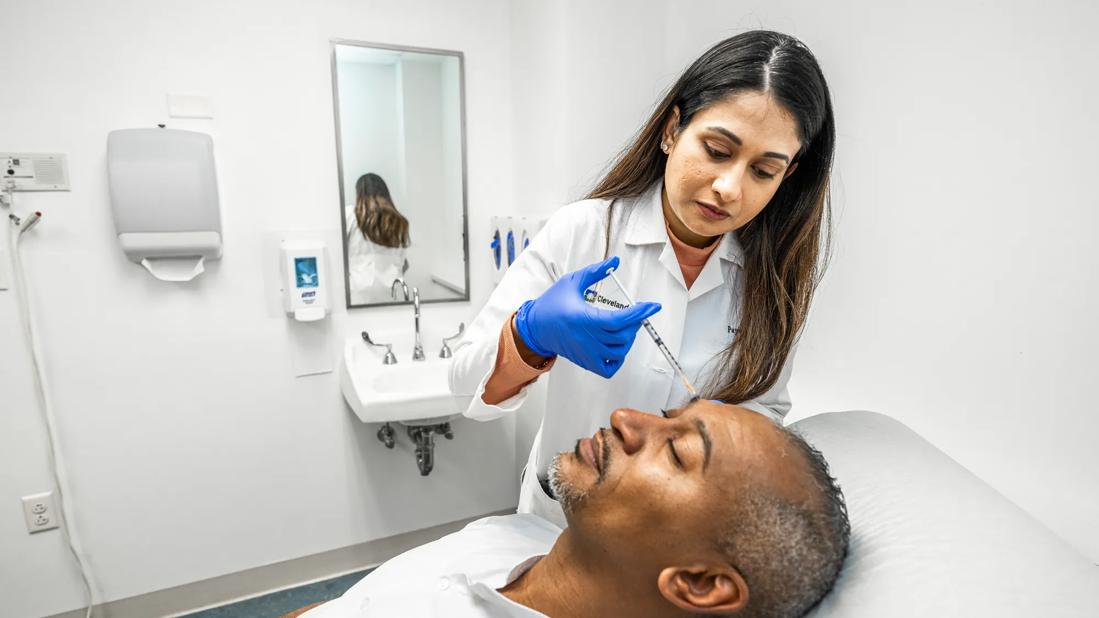Increasing the scope of care for headache patients

An estimated 70% of patients with migraine headaches also report neck pain, and roughly 30% of all types of headaches are related to neck disorders. The considerable overlap in the etiology and symptoms of the two types of conditions means they’re almost as likely to be treated by pain management specialists in the Department of Pain Management as they are by headache specialists in Cleveland Clinic’s Headache and Facial Pain Clinic, part of the Center for Neurological Restoration.
Advertisement
Cleveland Clinic is a non-profit academic medical center. Advertising on our site helps support our mission. We do not endorse non-Cleveland Clinic products or services. Policy
This frequent overlap partly explains why perhaps one of the clearest examples of interdisciplinary collaboration at Cleveland Clinic can be found in the work of the clinicians within these two specialties. There’s a lot of sharing and cross-fertilization of expertise going on to help liberate headache patients from their pain.
“There’s so much commonality in the conditions we treat that it behooves us to have an appreciation for each other’s specialties and the clinical skills we bring to the table,” says pain management specialist Samuel W. Samuel, MD. “We often work together. It’s a level of cooperation and a scope of diagnostic and therapeutic capability that we — and our patients — are fortunate to have.”
Dr. Samuel observes that because headache is a form of chronic pain, it makes sense that the headache specialists would refer many of their patients to Pain Management, where patients can receive treatment using a variety of safe and effective interventional procedures, including:
The pain management specialists treat some of the most complex and challenging headache conditions, including cervical spondylosis; cervical stenosis; and occipital neuralgia, a disorder characterized by chronic pain that manifests in the upper neck, back of the head, and behind the ears.
Advertisement
The relationship between the pain specialists and the headache specialists is undeniably a reciprocal one. “We often refer our headache and chronic neck pain patients to the Headache Clinic as well,” Dr. Samuel says. There, patients can receive a comprehensive history and evaluation to help determine the cause of a condition. The Clinic’s deep diagnostic expertise, supported in some cases by CT or MRI studies, can help the pain management clinicians determine the optimal course of treatment when interventional methods are used. In many cases, infusion therapy or medical management of a headache disorder by the Headache Clinic provides a valuable complement to interventional treatment.
For example, a patient with a whiplash injury who is referred by their primary care physician to a pain clinic at Cleveland Clinic for treatment may also experience headaches caused by the injury. Some of these patients might benefit from a referral to the Headache Clinic where specialists can prescribe medication to help manage their symptoms.
“Pain Management sees various disorders that fall within our school of expertise, like trigeminal neuralgia, migraine and cluster headaches,” says Emad Estemalik, MD, Section Head of Headache Medicine. “We do some of the procedures, such as Botox injections and some nerve blocks, but then we might send them over to Pain Management for some of the more sophisticated procedures, such as cervical injections. It depends on the scope of the treatment required.”
Advertisement
Dr. Samuel reports promising work at Cleveland Clinic in the treatment of cluster headaches, an excruciating disorder marked by severe stabbing pain on one side of the face, often over one eye, one temple, or the forehead. It is also one of the toughest headache disorders to treat.
“We are having success using RFA to achieve longer term results for patients with cluster headaches,” Dr. Samuel says. The use of ultrasound guidance (USG) with RFA is enabling interventional pain management specialists to locate therapeutic targets with much greater precision.
USG is also being used increasingly as a diagnostic tool in conjunction with RFA for various other kinds of headaches as well, because it allows clinicians to see the tissues, muscles, nerves and blood vessels with unparalleled clarity.
Dr. Estemalik pointed to the introduction to the market of three new FDA-approved drugs for preventive migraine treatment in adults as one of the most exciting recent developments in headache treatment. The new class of therapy relies on monoclonal antibodies designed to target calcitonin gene-related peptide (CGRP), a protein known to cause the pain in migraine, or its receptor in trigeminal pain pathways.
The anti-CGRP treatments are erenumab (Aimovig™), introduced in May 2018, and galcanezumab (Emgality™) and fremanezumab-vfrm (AJOVY™), both introduced in September. Administered subcutaneously, all three drugs carry a low incidence of side effects. Though not all patients respond to this class of treatment, a significant proportion do.
Advertisement
Advertisement

Increasing treatment options are extending the window for continued functional gains

Today’s research helps illuminate tomorrow’s needs

Case-control study yields evidence of epigenetic aging in pediatric-onset MS

Input from these central stakeholders is leading us to design for healing and hope

Proteins related to altered immune response are potential biomarkers of the rare AD variant

Multidisciplinary perspectives on the importance of early referral and more

Screening tool helps flag conditions that warrant further attention

As genetic insights refine diagnosis, research abounds on current and emerging therapies